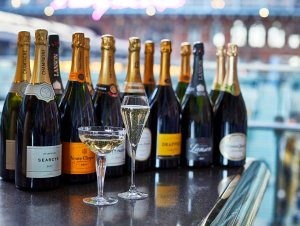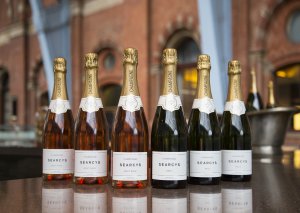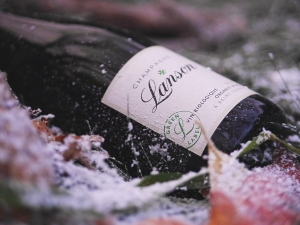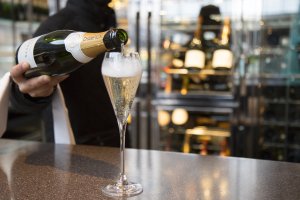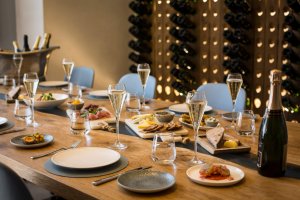-
Friday, 22 October marks World Champagne Day!
19 October 2021World Champagne Day is one of the biggest annual events in the calendar of sommeliers, Champagne makers and connoisseurs worldwide. Here at Searcys, we take the art of Champagne very seriously – from sourcing the very best growers and producers, to finding the perfect glassware, pour and food pairing. St Pancras Champagne Bar might be our sparkling wine hub, with the UK’s first dedicated Champagne School and the longest Champagne bar in Europe, but the eponymous French bubbles play a huge role across all our venues.
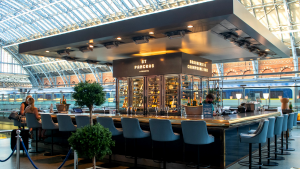
To celebrate World Champagne Day, we’re taking a look at famous Champagne lovers, a couple of inside stories from our drinks experts, and the reasons why Champagne has stood the test of time as the ultimate celebratory drink.
First things first, why Champagne?
More than any other drink, a glass of Champagne signifies a special occasion: a gathering of loved ones to celebrate something special. To get a handle on just how much Champagne is linked to the art of celebration and revelry, we speak to Martin Dibben, an old friend of Searcys and the prestigious Seneschal of the Ordre des Coteaux of Champagne.
There’s a very simple reason why Champagne is so often used to get the party started, and that is the bubbles. Dibben explains: “Bubbles get the alcohol quickly into your bloodstream, so it gives you a very good effect and gets the party going almost from that first sip.”
Beyond the science, however, there is a perception of quality and attention to detail that goes into producing a bottle of Champagne. Because it’s double fermented, the second time being in the bottle, there are a lot more complex stages behind Champagne production, compared to certain other sparkling wines, which can be made in far larger quantities.
This comes across in the complexity of tasting notes. As Martin explains, “Champagne is all about the region: the summers are hotter, so the vines are more stressed, the terroir is different, the winters are colder, so that’s all part of developing the unique flavour profile of Champagne from Champagne.”

Famous Champagne Lovers
Of course, the case for Champagne has been helped by having some fairly big supporters throughout the decades. Here are a few of our favourites:
Perrier-Jouët was Queen Victoria’s Champagne of choice. From 1856 onwards, she served the famous Champagne house’s drier “Brut” at banquets at Blenheim Palace and Kensington Palace, with the rest of high society scrambling to follow suit.
Winston Churchill famously drunk Pol Roger Champagne, and a lot of it: some sources estimate he drunk in incredible 42,000 bottles in his lifetime. The Prime Minister once said “Champagne should be dry, cold and free,” and another time supposedly commented “Champagne is the wine of civilisation and the oil of government.”
Napoleon said of Champagne: “In victory you deserve it; in defeat you need it”.
The Abbé de Chaulieu (1715) wrote upon first tasting Champagne, “Hardly did it appear, than from my mouth it passed into my heart”.
Noel Coward, when asked why he drank Champagne for breakfast every morning enquired, “Doesn’t everyone?”
A former Archbishop of Reims once said, ‘One sometimes drinks too much, but never enough.’
French Ambassador in Washington, said soon after the great Wall Street crash: ‘Between crisis and the catastrophe, there is always time for a glass of Champagne.’
George Bernard Shaw: ‘I’m only a beer teetotaller, not a Champagne teetotaller.’
American writer Mark Twain famously wrote “Too much of anything is bad. But too much Champagne is just right.”
Coco Chanel said: “I only drink Champagne on two occasions, when I am in love and when I am not.”
Last but not least, the Champagne heiress Lily Bollinger (1961) herself succinctly put her drinking habits like this: “I drink Champagne when I’m happy and when I’m sad. Sometimes I drink it when I’m alone. When I have company, I consider it obligatory. I trifle with it if I’m not hungry and drink it when I am.”

The Heritage of Searcys and Champagne
In many ways, the long legacy of Searcys and Champagne have a lot in common. Searcys dates back to 1847, when the confectioner to the Duke of Northumberland decided to take his talents to London and found his own hospitality company. It was the age of Victorian soirees and lavish aristocratic dinners, and Searcys soon became a hit amongst the capital’s high society, gaining a reputation as the go-to events company for exceptional quality.
Champagne, naturally, was a large part of these festivities. Queen Victoria was a staunch Champagne fan, setting the pace for the rest of the British upper classes. By 1893, we see the first mention of Searcys Own Cuvée. That year’s catalogue called attention to the Champagne specially prepared for and shipped by Searcys, the De Garnier et Cie 1893 vintage at 66 shillings for a dozen bottles. Searcys 21st-century own cuvees are available to be sampled at our restaurants and venues, as well as purchased online here.

To celebrate World Champagne Day this year, Searcys are hosting an intimate Lanson Dinner at St Pancras Brasserie and Champagne Bar and our newly launched 116 Pall Mall Champagne Bar. For one day only, guests will also be able to sample an exclusive pour of the extremely limited edition and exceptional vintage Le Clos Lanson 2006, straight from the private vineyards of Maison Lanson Family.
Champagne Against All Odds
This year at Searcys Champagne School, Searcys Drinks Ambassador Bruno Pelletier has pulled together a list of three very special Champagnes for guests to celebrate being together in person once more – with the masterclass named the Champagne Remedy. Pelletier explains his choices of three carefully selected bottles: “We have chosen to spotlight three well-known houses, which have also shown resistance in the face of adversity. From Bollinger, which produced an exclusive cuvée from post phylloxera vines, the only one left in Champagne, Drappier that salvaged its grapes from one of the worst weather conditions in 2012, to the Grande Dame of Champagne, Madame Clicquot, who built her Champagne empire against the odds.” The bottles were part of the first Champagne masterclass after lockdown ended, and remain on the drinks list.

How to Serve Champagne
Should you opt for a vintage style Champagne Coupe, a traditional flute, a tulip shaped glass or even a white wine glass? It all depends on the occasion and the Champagne in question. Searcys’ drinks ambassador Bruno Pelletier shares his thoughts on the different glassware.
“Inspired by the glitz and glamour of the 1920s, the saucer-shaped coupe is the classic glassware first designed for Champagne. Its wide bowl allows the drink to ‘open up’ giving the Champagne a fuller taste. For those who prefer a bit more fizz, experts recommend the flute, which enhances the flow of bubbles and Champagne’s aroma. Whichever you choose, both can be held by the stem to keep them cool and refreshing.”
When it comes to the perfect serve, there’s a lot that goes into it too. The bottle should be chilled to between 7 and 9ºC, and placed in an ice bucket filled halfway with ice and water, placed on a neatly folded napkin. There is an art to tilting the bottle and pulling out the cork without spraying bubbles everywhere, presenting it to the lucky recipients to taste. Find out more of Bruno Pelletier’s tips on the perfect serve here:
https://searcys.co.uk/the-perfect-champagne-serve/

How to pair Champagne With Food
Martin Dibben is an expert when it comes to pairing Champagne with food – and is always guided by the principle that the food should be chosen to suit the Champagne, and not the other way round. He shares his tips on pairing with us here:
“When you’re pairing with food – taste the Champagne first. Then taste the menu. Then drink another sip of Champagne. The Champagne should taste exactly the same. But if you serve something spicy for example, the fizz might taste bad afterwards. I like to choose my Champagnes then find food to go with it, rather than the other way round.
“Fish often goes very well, as do creamy desserts like panna cotta. We did a tasting once where we had raspberries, and from the initial tasting to the dinner the raspberries became much sweeter as it was later in the season, so everything changed. Truffle is also great with Champagne.”
Searcys’ Did You Know
- Champagne contained in a magnum matures more slowly and for a longer period of time, resulting in “a more complex and harmonious taste.”
- In 2021, Britain is Champagne’s #1 export market by volume. We consume the most Champagne in the world outside of France – surpassing even the USA.
- Typically, Britain consumes 25-30 million bottles per year with a value of almost 430 million euros.
- The UK is one of the original Champagne markets. From the 17th century right through to today, our histories have been inextricably linked. It’s a love-affair that has lasted for over 300 years.
- James Bond has been spotted drinking Champagne more than 35 times and counting throughout the movie franchise, more than Martinis or any other drink.
- The biggest bottle of Champagne to be produced is called a Melchizedec. It holds 30 litres, equivalent to 40 standard 75cl bottles of champagne.
- The pressure in a bottle of Champagne is equivalent to that of a tyre on a London double-decker bus.
- Historically Champagne was seen as dangerous because the bottles had a tendency to shatter under pressure, and Champagne makers wore metal masts to protect their faces from exploding glass. Eventually, stronger glass bottles and metal clasp closures made the bottles more stable.
- Despite being approximately one fifth of the size of London, Champagne produces around 300 million bottles every year with a turnover of 5 billion euros.
- The Champagne region is made up of 34,300 hectares under vine, 280,000 vineyard plots, 16,000 winegrowers, 140 cooperatives, 340 Champagne Houses creating 30,000 jobs.
- Champagne was the first wine-growing region in the world to collectively carry out a carbon footprint assessment and identify the main sources of emissions.

Searcys’ top tips for drinking Champagne
- Always serve it from a magnum if you are able to. It’s the perfect volume so it evolves best in the bottle, plus it’s fun.
- Think carefully about glassware. more and more now we’re coming round to the idea that it should be drunk not in a flute but in a white wine glass, one that you’d maybe choose for Sauvignon, as you can taste it much better. When we taste really old vintages, we sometimes use red wine glasses. Coupes are fun, why not, but it’s not technically the best way to drink Champagne.
- Think about season too. In the summer you might like to go for a rosé, or a lighter style Champagne like Searcys for example, whereas in winter you might prefer something biscuity like Veuve Clicquot.
- ABOUT SEARCYS
- About Searcys
- News
- All News
- Searcys x Sociability Blog
- Raise a Glass: Celebrate English Wine Week with Searcys
- a Day of Insight and Impact at the ESG Forum at 116 Pall Mall
- Searcys and the Barbican host isla’s “Made Possible Festival” A One-Stop Event Sustainability Summit
- Plan the Ultimate Summer Soirée with Our Spectacular London Venues
- Private Dining Now Available at the Barbican Conservatory
- A Fresh Taste of Artful Hospitality at the National Gallery
- Reservations open for Locatelli
- The Business of Events: A Westminster Dinner to Remember
- Restaurants and Bars
- Event Venues
- EVENT SPACES
- All Locations
- {10-11} Carlton House Terrace
- 30 Euston Square
- 41 Portland Place
- 116 Pall Mall
- Barber-Surgeons Hall
- Battersea Power Station
- Carpenters’ Hall
- Church House
- Gray’s Inn
- Horizon 22
- IET London: Savoy Place
- National Army Museum
- No. 11 Cavendish Square
- One Moorgate Place
- Saddlers’ Hall
- Searcys at The Gherkin
- EVENT SPACES cont.
- Searcys Bar and Brasserie at Surveyors House
- Stationers’ Hall
- St Pancras Bar & Brasserie
- Surveyors House
- The Barbican
- The HAC
- The Inner Temple
- The Portrait Restaurant By Richard Corrigan
- The Roman Baths and Pump Room
- The Royal Institution
- The View, Royal College of Surgeons of England
- Vintners’ Hall
- Event Types
- SEARCYS ROLLS-ROYCE
- Let Us Find Your Venue
- Event Catering
- What’s On
- Contact Us
- ABOUT SEARCYS
- About Searcys
- News
- All News
- Searcys x Sociability Blog
- Raise a Glass: Celebrate English Wine Week with Searcys
- a Day of Insight and Impact at the ESG Forum at 116 Pall Mall
- Searcys and the Barbican host isla’s “Made Possible Festival” A One-Stop Event Sustainability Summit
- Plan the Ultimate Summer Soirée with Our Spectacular London Venues
- Private Dining Now Available at the Barbican Conservatory
- A Fresh Taste of Artful Hospitality at the National Gallery
- Reservations open for Locatelli
- The Business of Events: A Westminster Dinner to Remember
- Restaurants and Bars
- Event Venues
- EVENT SPACES
- All Locations
- {10-11} Carlton House Terrace
- 30 Euston Square
- 41 Portland Place
- 116 Pall Mall
- Barber-Surgeons Hall
- Battersea Power Station
- Carpenters’ Hall
- Church House
- Gray’s Inn
- Horizon 22
- IET London: Savoy Place
- National Army Museum
- No. 11 Cavendish Square
- One Moorgate Place
- Saddlers’ Hall
- Searcys at The Gherkin
- EVENT SPACES cont.
- Searcys Bar and Brasserie at Surveyors House
- Stationers’ Hall
- St Pancras Bar & Brasserie
- Surveyors House
- The Barbican
- The HAC
- The Inner Temple
- The Portrait Restaurant By Richard Corrigan
- The Roman Baths and Pump Room
- The Royal Institution
- The View, Royal College of Surgeons of England
- Vintners’ Hall
- Event Types
- SEARCYS ROLLS-ROYCE
- Let Us Find Your Venue
- Event Catering
- What’s On
- Contact Us
Saved Venues0Stay Connected with Searcys
Sign up to receive updates on exclusive events, restaurant offers, and more from Searcys.
